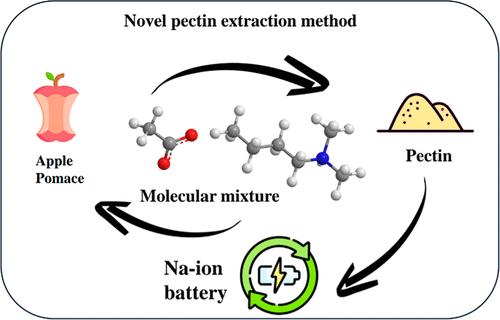从可回收的分子混合物中提取果胶:准固态钠离子电池多孔膜的有前途的材料
IF 7.3
1区 化学
Q1 CHEMISTRY, MULTIDISCIPLINARY
引用次数: 0
摘要
在这项工作中,我们探索了从苹果渣中提取果胶的溶剂基提取方法,并评估了提取的果胶作为多孔准固态钠离子电池膜的前体,同时测试了从商业果胶中提取的硬碳作为电极材料。对10种不同的离子液体(IL)和6种不同的反溶剂进行筛选发现,N,N-二甲基乙酸丁铵([DMBA][OAc])与乙醇结合,在果胶提取中非常有效,而同样的IL与1-丁醇作为反溶剂,可以得到更纯净的果胶产品。此外,[DMBA][OAc]的行为不像IL,类似于基于1H NMR和电导率测量的分子混合物。采用双水平分式设计,考虑温度、固体载荷、酸碱比(ABR)和il含水量等4个因素,其中温度和固体载荷是影响因素。最佳的提取条件为:温度80°C,时间1小时,固体负荷为15%,ABR为1.1,含水量为30%,可得9.6%的果胶。所得到的准固态钠离子半电池在C/20下的容量为~ 130 mAh g-1,使其成为储能应用的绝佳候选材料。本文章由计算机程序翻译,如有差异,请以英文原文为准。

Pectin Extracted by a Recyclable Molecular Mixture: A Promising Material for Porous Membranes in Quasi-Solid-State Na-Ion Batteries
In this work, we explored a solvent-based extraction of pectin from apple pomace and evaluated the extracted pectin as a precursor for porous quasi-solid-state Na-ion battery membranes, alongside testing hard carbon derived from commercial pectin as an electrode material. A screening of 10 distinct ionic liquids (ILs) and 6 different antisolvents revealed that N,N-dimethylbutylammonium acetate ([DMBA][OAc]), combined with ethanol, was highly effective in pectin extraction, while the same IL with 1-butanol as antisolvent yielded a purer form of the pectin product. Additionally, [DMBA][OAc] did not behave as an IL and resembled a molecular mixture based on 1H NMR and conductivity measurements. A two-level fractional design was employed with four factors, considering temperature, solid loading, acid-to-base ratio (ABR), and water content of ILs, where temperature and solid loading were significant factors. The optimized conditions for the pectin extraction were at 80 °C, 1 h, with 15 wt % of solids loading, an ABR of 1.1, and 30 wt % of water content (IL), which yielded 9.6 wt % of pectin. The resulting quasi-solid-state Na-ion half-cell exhibited a capacity of ∼130 mAh g–1 at C/20, making it an excellent candidate for energy storage applications.
求助全文
通过发布文献求助,成功后即可免费获取论文全文。
去求助
来源期刊

ACS Sustainable Chemistry & Engineering
CHEMISTRY, MULTIDISCIPLINARY-ENGINEERING, CHEMICAL
CiteScore
13.80
自引率
4.80%
发文量
1470
审稿时长
1.7 months
期刊介绍:
ACS Sustainable Chemistry & Engineering is a prestigious weekly peer-reviewed scientific journal published by the American Chemical Society. Dedicated to advancing the principles of green chemistry and green engineering, it covers a wide array of research topics including green chemistry, green engineering, biomass, alternative energy, and life cycle assessment.
The journal welcomes submissions in various formats, including Letters, Articles, Features, and Perspectives (Reviews), that address the challenges of sustainability in the chemical enterprise and contribute to the advancement of sustainable practices. Join us in shaping the future of sustainable chemistry and engineering.
 求助内容:
求助内容: 应助结果提醒方式:
应助结果提醒方式:


